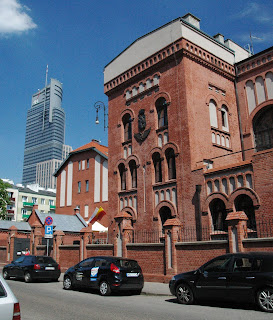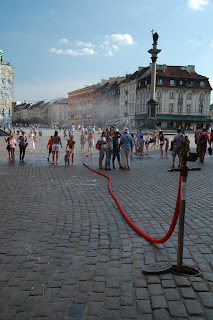We took the bus in to pl. Zawiszy, only a couple of block's walk from the Warsaw Rising Museum. On the way, we stopped off near the bus stop and bought two 24-hour tickets for all transport (that you can't buy on board the bus) — it was too hot to be doing too much walking today!
On the way to the museum, we passed a statue of Stefan Kuryłowicz, an influential Polish architect credited with the modernisation of the Warsaw skyline in the post-communist era.
We got to the Museum, and realised that on such an anniversary — August 5 was the anniversary of Black Sunday, when over 40,000 citizens in the district of Wola are massacred by the Germans — there were bound to be crowds coming to visit here. But the queues were moving quickly, and we were soon inside. This museum is the most sobering of places to go through — nothing is held back, so you see the worst of war. The heart of the building is a huge metal monolith passing right through the ground and first floors. Its surface bears the Anchor symbol of the Warsaw Uprising, and each of the dates of the 63 days that the uprising ran. But it is even more the heart of the display — there is a loud heartbeat coming from the monolith — the heartbeat of the Uprising — which can be heard throughout the building.
We discovered that all the workings of a living city were set up during that period. The Post Office was fully functional, using boy scouts as delivery boys. Water was an issue, and there were numerous wells dug around the city — but it was always hazardous to collect water, as the well-heads were under intermittent fire from German snipers. Kitchens were set up to supply the population with hot food. One of the dishes was 'spit soup', a soup made from coarsely-ground barley — you ended up spitting out the husks at the end.
We saw a replica of Radio 'Lightning', the clandestine radio station that ran for the entire uprising.
There is a rather poignant display about the 'Robinsons', those Warsaw citizens who were trapped inside the city after its fall, and had to eke out their lives in appalling conditions. Many of them were Jews who had no way of getting out of the city. The story of one of these — whose portrait features in the display — was the Polish pianist Władysław Szpilman, who survived the Warsaw Ghetto, and remained in Warsaw through the Uprising, to become one of the Robinsons. His story is told in the 2002 Roman Polanski film 'The Pianist'.
After spending a couple of hours in the Rising Museum, we were in need of something less traumatic. But first we decided on a very light lunch, a hotdog and coffee in the museum's courtyard café. Then we made our way by Metro train from Rondo Daszyńskiego station to the Nowy Śiat-Uniwersytet station — this is on the M2 line, which has only been open for about 5 months — and walking to the Fryderyk Chopin Museum. On the way, we passed the Nikolas Copernicus statue. Near it, they had set up a 'fire-hose fountain', and children (and their elders!) were enjoying getting wet on a hot summer day.
Opposite the Copernicus Statue is the Holy Cross Church, in which Chopin's heart is buried.
We got round to the Chopin Museum. This is brilliantly set up — your ticket is an electronically-coded card which, when you apply it to sensors on the displays, starts up the commentary in your own language! You can discover Chopin to virtually any depth. There are, for example, projected facsimile scores synchronised to audio files of Chopin's music. We could explore to our heart's content, and just enjoy the music, or find out about Chopin's childhood, or his mature years, his circle of friends and colleagues, and even to his tragically early death at the age of 39 — apparently his heart was significantly enlarged, so it is likely that some heart condition, as well as tuberculosis, hastened his end. But this museum was a delight — although we never found his Revolutionary Étude (op.10 no.12), one of Warren's favourites!

Andrew Carrick Gow - A musical story by Chopin (1879)
(Young Fryderyk aged 6-8 among the pupils of his father's boarding house —
based on an apocryphal story by Maurycy Karasowsky)
After Chopin, we went up to the New City (Nowe Miasto) where wee were on Monday. This time the Marie Skłodowska-Curie Museum was open, so we went in to commune with one of the great scientists of the twentieth century. In the museum there were photographs of the attendees at various scientific meetings — names such as Rutherford, Bohr, Dirac, Compton, De Broglie, Planck, Heisenberg, Einstein, Schroedinger, Lorenz were popping off the captions of the photos. Warren found this as fascinating as Marie Curie herself!
We walked back towards our bus stop, passing through the square Kanonia again, where there is an old bell, made by Daniel Tym for one of the town's churches in 1646. Legend has it that to have a wish come true, you need to touch the top of the bell and walk around it once once. For a bigger wish, you need to go round three times. To change the weather in Warsaw is only counted as a small wish, as the weather here is reputed to be like a woman's mind, and changing every fifteen minutes!
Coming back out past the royal Palace, we found another 'fire hose fountain' set up in front of it — and those taking advantage of it were certainly a bit older than the ones near Copernicus!
Anyway, after another full day, we made our way back to the camp for a leisurely dinner, a Movie — we decided on the 1937 film 'Topper' for a bit of a change! — and then sleep!
Distance driven — today, nil; to date, 25,033 miles ( 40,387 km )

































Wonderful-Did you find out about Krystina? I'd have just stayed with the Chopin all day I think. How lucky we humans are to have had wonderful artists, poets and musicians. They sing from the depths of our hearts and souls for us, some of them. The Sculthorpe is still playing and I am still liking it. Must get back into damned obesity- not that I've ever got right away from it really.. Love ya. travel safe, Cathy.
ReplyDelete